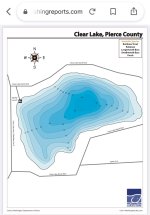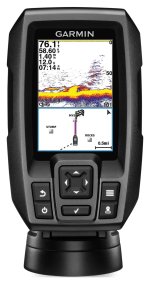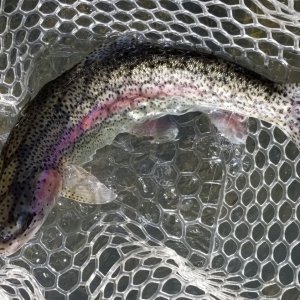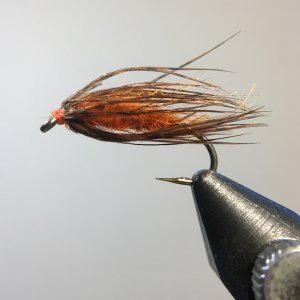The publisher said, "no Lue and Steve, no book." I was over a barrel.Great minds think alike Scott.....but Ford Fenders books.....Lue and Steve are in both of them......(Excellent Lake books!)
Navigation
Install the app
How to install the app on iOS
Follow along with the video below to see how to install our site as a web app on your home screen.
Note: This feature may not be available in some browsers.
More options
Style variation
You are using an out of date browser. It may not display this or other websites correctly.
You should upgrade or use an alternative browser.
You should upgrade or use an alternative browser.
Trout behavior in lakes
- Thread starter Emily27
- Start date
Engee
Steelhead
Sonar, although I am no expert. I fished for years without a fish finder (sonar unit) but lately have been trying to learn. Fish finding ability is questionable, but the ability to see topography, structure and depth is very helpful.Thanks for the advice everyone, as a follow-up question how do y'all go about figuring out what the topography of a lake is/where structure is? past the stuff that I can see in the water and following the topography trends above water as bambooflyguy suggested, is it mostly just trial and error figuring out where stuff is by what I can feel my fly doing, or are there more reliable ways to figure it out. Like if you were going to a lake or pond for the first time without knowing much about it prior how would you go about deciding where things are and what you want to fish to?
This website has a number of bathymetric (underwater topo) maps that can help.how do y'all go about figuring out what the topography of a lake is/where structure is?
And this Google Search can locate more.
Here’s a good resource for bathymetric maps in Oregon.Thanks for the advice everyone, as a follow-up question how do y'all go about figuring out what the topography of a lake is/where structure is? past the stuff that I can see in the water and following the topography trends above water as bambooflyguy suggested, is it mostly just trial and error figuring out where stuff is by what I can feel my fly doing, or are there more reliable ways to figure it out. Like if you were going to a lake or pond for the first time without knowing much about it prior how would you go about deciding where things are and what you want to fish to?
Good lakes for trout fly fishing have a lot of relatively shallow water, say <30’ deep. These are the zones that grow food and can be accessed with fly gear.
Me too. Unfortunately my background with fighter weapons control RADAR makes the capabilities of a relatively affordable "fish finder" SONAR like my Garmin Striker 4CV seem awfully basic. It paints fish, but I can see them only briefly in the real time "A scope" pane before they go into the main "historical" pane. In that pane I can see the size of the fish and what depth they are at, but I cannot tell what direction or distance they are at in relationship to me nor if they are stationary, or moving - direction of travel. It does show structure that I can mark with waypoints to reference in the future. The fish finder does have other usable features such as water temp, and mapping to show bottom contours under me that it retains and can be added to (widened) with multiple passes over an area AND is available for future visits. It also displays my heading and speed.Sonar, although I am no expert. I fished for years without a fish finder (sonar unit) but lately have been trying to learn. Fish finding ability is questionable, but the ability to see topography, structure and depth is very helpful.
This YT channel's series on the Garmin Striker 4 is a about the best and most comprehensive I've seen on the Striker 4's capabilites so far.
Go to www.northwestfishingreports.com and search for bathymetric maps for most WA state lakes.I think......if ya look up the lakes on the wdfw site, it has topo maps.
for example:


BriGuy
Life of the Party
Foam lines also can appear in the sound since the water is nearly always moving. I've had some luck fishing them for searun cutts.The lake I see the foam lines the most is just into EWA. Winds go from 0 to 30+ at 11:30am in the morning (talk about getting blown off the lake). By about 5:00pm they die down and the foam lines appear. Are fun to fish too... Everything you just said
Now I can put a name to it: Langmuir Circulation. Learn something every day...
At the simplest level the difference in trout behavior in rivers and lakes is that in rivers the trout set up feeding locations allowing the current to bring their food to them. In lakes the food is more scattered, and the trout are more actively searching for feeding location. The key to locating lake feeding trout is understanding their primary food sources, where and when it is most available to the trout. By understanding how each of the major food items (chironomids, mayflies, scuds, dragon and damsel flies, etc.) life histories, preferred habitat the angler can begin predicting and adjusting their fishing approach.
Curt
Curt
My two favorite words!At the simplest level the difference in trout behavior in rivers and lakes is that in rivers the trout set up feeding locations allowing the current to bring their food to them. In lakes the food is more scattered, and the trout are more actively searching for feeding location. The key to locating lake feeding trout is understanding their primary food sources, where and when it is most available to the trout. By understanding how each of the major food items (chironomids, mayflies, scuds, dragon and damsel flies, etc.) life histories, preferred habitat the angler can begin predicting and adjusting their fishing approach.
Curt
DryFly82
Steelhead
Start with focusing on what the fish needs:
Food: The majority of the lake ecosystem (both plant and animal life) will be in less than 20 feet of water. Deeper than 20 feet and you start getting beyond the zone where plants will grow because the sunlight cannot reach the bottom. Other than chironomid hatches most of the food will be in 20 feet or less.
Safety: Fish prefer structure that provides protection and the ability to escape quickly. For this reason, the edge of weed beds, rocks, snags, points, drop-offs are all attractive areas for fish. During full daylight hours (especially bright days) they will avoid going too shallow if there is food to be had in the 10-20 foot zone. During dawn and twilight hours you will be more likely to find fish in shallow and near the surface as they feel less exposed.
Comfort: Trout prefer water that is 44-67 degrees. This means that in the heat of the summer they will be down deep during the day and become more active at dawn and dusk. During the spring and fall you will find them nearer to the surface and closer to the edges and they will be more active during the warmest parts of the day. Temperature also affects their aggressiveness. The closer you get to the edge of their comfort level the less likely they are to chase a fast-moving food source.
Overall: Trout feed on and off throughout the day. Sometimes it will be lights out for 30-60 minutes and then it will just go dead. The fish often move and sometimes they will just be done for a few hours. The key is to put in the time to be ready for when they do turn on. If they were feeding on chironomids or something small and that suddenly ends, it might be worth throwing a leech, booby, or something else big to change the dynamic. When you find the fish that is a great time to focus on casting, but if you don’t know where they are in a lake it would be worth trolling to see if you can locate them…then cast again.
I'd also recommend checking out Brian Chan and Phil Rowley on YouTube. They the foremost experts when it comes to trout fishing in lakes.
Food: The majority of the lake ecosystem (both plant and animal life) will be in less than 20 feet of water. Deeper than 20 feet and you start getting beyond the zone where plants will grow because the sunlight cannot reach the bottom. Other than chironomid hatches most of the food will be in 20 feet or less.
Safety: Fish prefer structure that provides protection and the ability to escape quickly. For this reason, the edge of weed beds, rocks, snags, points, drop-offs are all attractive areas for fish. During full daylight hours (especially bright days) they will avoid going too shallow if there is food to be had in the 10-20 foot zone. During dawn and twilight hours you will be more likely to find fish in shallow and near the surface as they feel less exposed.
Comfort: Trout prefer water that is 44-67 degrees. This means that in the heat of the summer they will be down deep during the day and become more active at dawn and dusk. During the spring and fall you will find them nearer to the surface and closer to the edges and they will be more active during the warmest parts of the day. Temperature also affects their aggressiveness. The closer you get to the edge of their comfort level the less likely they are to chase a fast-moving food source.
Overall: Trout feed on and off throughout the day. Sometimes it will be lights out for 30-60 minutes and then it will just go dead. The fish often move and sometimes they will just be done for a few hours. The key is to put in the time to be ready for when they do turn on. If they were feeding on chironomids or something small and that suddenly ends, it might be worth throwing a leech, booby, or something else big to change the dynamic. When you find the fish that is a great time to focus on casting, but if you don’t know where they are in a lake it would be worth trolling to see if you can locate them…then cast again.
I'd also recommend checking out Brian Chan and Phil Rowley on YouTube. They the foremost experts when it comes to trout fishing in lakes.
Where and when…….. I keep asking you, but you never divulge the info! I have to keep asking @Scott Salzer, the “Trout Oracle”.My two favorite words!













